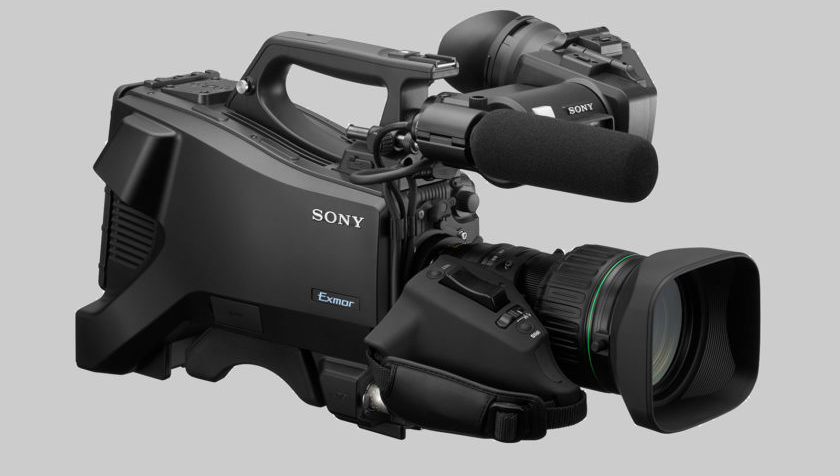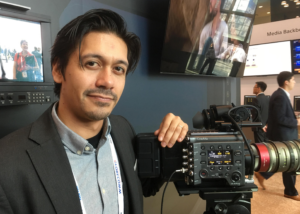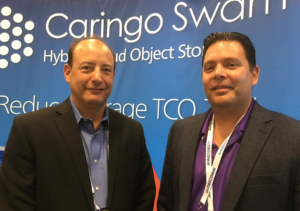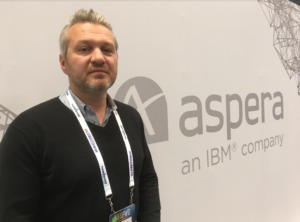M+E Connections

NAB Show New York 2017: Sony Touts New Cameras, Caringo Spotlights Reach Integration
Story Highlights
NEW YORK — Sony, Caringo and IBM’s Aspera division were among the many members of the Media & Entertainment Services Alliance (MESA) that showcased their latest products and services at NAB Show New York Oct. 18-19 at Jacob Javits Convention Center.
Sony: New pro cameras were in the spotlight at Sony’s booth, where the company showed its 4K-ready HXC-FB80 portable camera, announced just ahead of the show on Oct. 16, and the full-frame Venice Ultra High-Definition that was unveiled in September.
The HXC-FB80, combined with Sony’s new HXCU-FB80 camera control unit (CCU), represent what the company called an “accessible entry into 4K-“ and High Dynamic Range (HDR)-ready studio and live production. The two devices will ship in January, according to Sony. Based on a 3G-SDI platform with 1080/59.94p capabilities, the new system fits a range of commercial applications where professionals require high-quality HD with a “future-proof” path to 4K and HDR production, it said in a news release.
The CCU upscales HD content to 4K (3840×2160). HD-HDR support for Hybrid Log-Gamma (HLG) will be available in summer 2018 through a free firmware upgrade, the company said. Since its introduction, Sony’s HXC series has been adopted globally for diverse uses and the latest addition to the line was “based on customer input,” while the added support for upscaled 4K and HD-HDR production “expands the system to a wider range of applications,” it said.
Venice is touted by Sony as the “first Full-Frame digital motion picture camera system,” and is the latest model in its CineAlta camera system line targeted at filmmakers. It was shown for the first time Sept. 6, in front of a select audience of American Society of Cinematographers members and other industry professionals, at Sony Pictures Studios in Culver City, Calif., and then spotlighted again by Sony at IBC in Amsterdam, Joe Schimizzi, Sony Electronics Professional Solutions Americas sales support engineer, said Oct. 18 at NAB Show New York.
Venice has a fully modular design including a “swappable”/interchangeable sensor, giving users the option to customize their camera by enabling the features needed, matched to their individual production requirements, according to Sony. Optional licenses for the camera will be available in permanent, monthly and weekly durations to expand capabilities with new features including 4K anamorphic and Full Frame, each sold separately, it said.
 Venice will ship in February and the resolution at launch is still being decided, but will be “absolutely” 4K at least, Schimizzi told MESA. Sony is looking to see if that can be boosted to 6K, he said, adding the price wasn’t decided yet either, but is expected to be in the $30,000-$40,000 “ballpark.” Sony intends to continue supporting the camera body for 4-5 years “at least,” he said.
Venice will ship in February and the resolution at launch is still being decided, but will be “absolutely” 4K at least, Schimizzi told MESA. Sony is looking to see if that can be boosted to 6K, he said, adding the price wasn’t decided yet either, but is expected to be in the $30,000-$40,000 “ballpark.” Sony intends to continue supporting the camera body for 4-5 years “at least,” he said.
Caringo
The Austin, Texas-based company focused on the integration of Caringo Swarm Hybrid Cloud Object Storage with the Reach Engine from Levels Beyond at the show. The Reach Engine software platform enables users to “seamlessly streamline complex workflows around video creation, library management, packaging and distribution and support the entire asset lifecycle from planning to development, management to approval, packaging to distribution, and analytics back to planning,” Caringo said in announcing the integration just before the show. The integration ensures that digital assets are “instantly available on-demand while securely tracking, preserving, and rapidly scaling the asset library,” it said.
“We’re seeing a lot more asset managers and overall applications” in the media and entertainment space support the Amazon Web Services Simple Storage Service (S3) application programming interface (API), Adrian Herrera, Caringo marketing VP, told MESA Oct. 18 at the show. “But there’s still security concerns with the cloud, so a lot of media and entertainment organizations don’t want to send their data to S3,” he said, adding those companies can now opt to use Caringo’s solution “to set up an S3-like service within their data center that supports the S3 API, so that they can still benefit from the ecosystem of applications like Reach Engine that are integrating S3 support.”
 Mobile access and Video-on-Demand are “rapidly changing the speed with which content producers create and deliver digital assets to an ever-growing variety of consumption points, where convenience is key,” Caringo said in a news release Oct. 17. As a result, the storage system “must respond to preserve these digital assets by rapidly expanding to keep pace with content creation while delivering each asset with the speed and variety required by on-demand consumption,” it said. Caringo Swarm integration with Reach Engine “powers a new era of content creation and curation, while future-proofing digital asset workflow storage and access for these rapidly scaling asset libraries,” according to the company.
Mobile access and Video-on-Demand are “rapidly changing the speed with which content producers create and deliver digital assets to an ever-growing variety of consumption points, where convenience is key,” Caringo said in a news release Oct. 17. As a result, the storage system “must respond to preserve these digital assets by rapidly expanding to keep pace with content creation while delivering each asset with the speed and variety required by on-demand consumption,” it said. Caringo Swarm integration with Reach Engine “powers a new era of content creation and curation, while future-proofing digital asset workflow storage and access for these rapidly scaling asset libraries,” according to the company.
“Reach Engine’s ability to enable smart, secure, elastic cloud services in sync with media workflow and supply chain automation fits seamlessly with Caringo Swarm’s ability to intelligently manage the cloud storage pool for content delivery and post-production workflows, Caringo VP of Product Tony Barbagallo, said. “This tight workflow integration allows our mutual customers to spend more time focused on providing quality content to their viewers instead of managing processes and infrastructure,” he said.
Benefits of the integration include the simplification of content creation and curation by seamlessly integrating with secure, scale-out storage; the ability to distribute content to traditional and non-traditional media outlets; and the ability to reduce storage total cost of ownership 75% with built-in content protection, Caringo said.
Aspera
IBM’s Aspera division used the show to tout its FASPStream technology that enables broadcast-quality live streaming over distance for remote editing and production. The company also focused on Aspera Files, Aspera Transfer Service and hybrid multi-cloud Software as a Service (SaaS) offerings for fast and secure collaboration connecting public and private clouds with on-premises infrastructure.
 “Streaming is fairly new for us,” Francois Quereuil, Aspera senior director of worldwide marketing, told MESA at the show Oct. 18. He explained: “For many years, we’ve been experts at moving really big files over the Internet or any sort of IP network. But we recently introduced the capability and the software to deal with growing files – so any sort of data streaming,” including high-quality video “over even fairly challenging networks,” with few if any glitches.
“Streaming is fairly new for us,” Francois Quereuil, Aspera senior director of worldwide marketing, told MESA at the show Oct. 18. He explained: “For many years, we’ve been experts at moving really big files over the Internet or any sort of IP network. But we recently introduced the capability and the software to deal with growing files – so any sort of data streaming,” including high-quality video “over even fairly challenging networks,” with few if any glitches.
While Aspera has been touting those streaming capabilities “for a little while,” what the company has been able to do more recently is integrate them into third-party products, he told us. One example was an integration with Telestream’s Vantage platform, announced Sept. 14 at IBC in Amsterdam. Telestream Vantage powered by Aspera combined Aspera’s FASPStream high-speed file transfer technology and Telestream Lightspeed Live Capture media processing platform to enable production teams to work on live video feeds from remote locations in near real time, the companies said. This and other integrations were spotlighted at the show.









